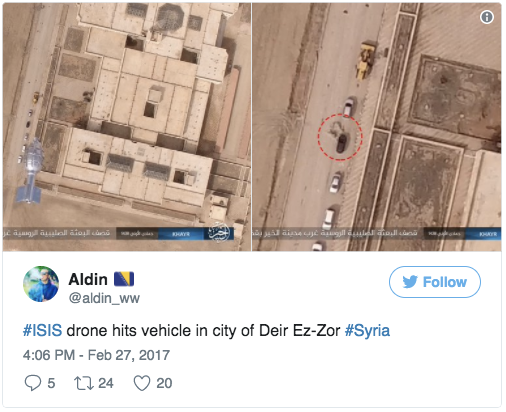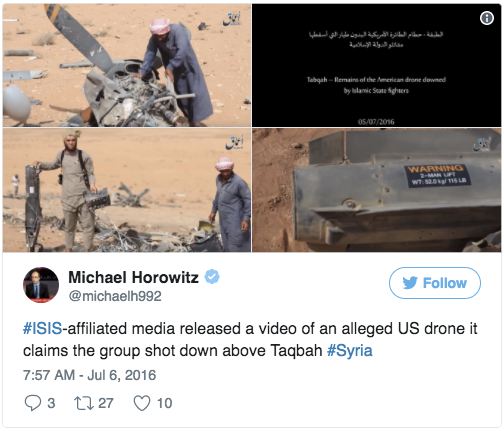Residents in Syria Favor Coalition Drones, Fear ISIS and Regime Drones
According to a recent Navanti survey, residents in Syria hold divided views on the use of drones in their areas, with some content with their use as a tool against the Islamic State in Iraq and Syria (ISIS), and others hopeful they could be used to deliver humanitarian aid. Others fear that any drones, or unmanned aerial vehicles (UAVs), used by ISIS or the Syrian regime could lead to human casualties.
The informal survey conducted by Navanti Group, which took place from April to May 2017, asked residents from four cities in Syria — Idlib, al-Raqqa, Deir al-Zour, and al-Hasakah — about their perceptions on the use of UAVs in their areas. The survey indicated that residents saw drones employed by a variety of factions — including the U.S.-led International Coalition, ISIS, the Syrian regime, and sometimes rebel groups — used primarily for military and intelligence purposes.
Though residents in Idlib, al-Raqqa and Deir al-Zour said they had seen UAVs, both the smaller commercial drones as well as the larger weaponized ones, none were spotted in the Syrian Democratic Forces-held al-Hasakah or the areas surrounding the city. Residents in ISIS-held Deir al-Zour said the UAVs they saw were surveillance drones belonging to either ISIS or the Syrian regime, while in al-Raqqa, locals claimed the UAVs all belonged to the International Coalition. In Idlib, however, residents said they saw many drones, both from the Syrian regime and the rebel groups, while some reported rare sightings of International Coalition UAVs.
Several foreign powers and factions have gradually introduced their own UAVs into the Syrian civil war since its outbreak in 2011, crowding the skies above Syria with both surveillance and armed drones. While countries such as Russia and Iran employ drones in support of Syrian President Bashar al-Assad, other countries such as Turkey, the U.S. and the U.K. have employed UAVs namely against ISIS and the al-Qa’ida affiliate Jabhat al-Nusra (later rebranded as Jabhat Fateh al-Sham, part of the Hayat Tahrir al-Sham coalition). Factions such as Hezbollah, Kurdish fighters, violent extremist organizations, and rebel groups have also been known to use drones in Syria. Hezbollah has even developed the capability for not just surveillance, but also weaponized UAVs, deploying them in many areas in Syria.
The sheer number of UAVs in Syria on competing missions has caused increased tension between stakeholders.
The video below, which shows a Russian drone monitoring a Coalition drone, was released by the Russian Ministry of Defense in 2015 to warn that number of coalition UAVs flying above Syria had tripled.
With a primarily military use in Syria, UAVs were perceived favorably or unfavorably by residents depending on which faction or country was operating them and the degree to which they trusted them. While residents seemed to favor drones if they perceived them as belonging to the International Coalition, they feared drones if they believed they belonged to ISIS or the Syrian regime of Bashar al-Assad. Respondents explained to Navanti that this was because residents believed Coalition drones were either more accurate in targeting ISIS and created fewer civilian casualties, or because the residents generally favored the International Coalition above other factions and thus supported their UAV targeting mission.
>
“My friends living in ISIS areas often are not scared of drones because they presume it is the International Coalition…In most cases, people know the coalition drones are pretty accurate and bombs are not too big so people are happy that these drones target ISIS.”
Despite the accuracy of Coalition drones, many residents still feared UAVs, as they explained that ISIS often uses civilians as human shields.
>
“Generally, [I view] Coalition drones positively because they tend to be precise, accurate, and limited to non-civilian targets. They are also easily detectable because they have the same sound as F-16s…People understand the Coalition drones are not deliberately targeting civilians, but ISIS uses them as human shields, so this creates fear.”
One survey respondent in Deir al-Zour believed UAVs were the best alternative for the Coalition’s fight against ISIS.
>
“I think they should keep using drones to fight ISIS and the regime because drones are safer than warplanes because there are no pilot casualties.”
Respondents in the survey also mentioned explicit fears of UAVs operated by ISIS.
>
“My friends who live in regime areas get scared from drones because they presume they are ISIS drones, which will attack indiscriminately and kill innocent people…ISIS also uses drones and they even use them to kill people. Most recently, they’ve killed 10 people with a bomb dropped from an ISIS drone,” explained another Deir al-Zour resident. “Anyway, people feel only fear when they see a drone. No matter whose drone it is, people get scared. ISIS still uses them today.”
Though not mentioned by respondents, ISIS also uses the smaller surveillance drones for propaganda purposes, such as filming aerial footage of enemy losses by attacks using suicide vehicles or improvised explosive devices. These clips are then posted online as an attempt to demonstrate the strength of the organization.
All respondents, however, unilaterally said UAVs would be accepted if used for humanitarian aid and expressed hopes that drones could be used as a means of delivering aid to dangerous areas and hard-to-access areas, where humanitarian conveys fail to reach. Despite past failed efforts to employ drones for humanitarian purposes, residents were still optimistic they could be used in the future.
>
“We would like to see drones being used for aid drops if possible.”
Looking forward, the U.S.-led International Coalition seems to have Syrian public perceptions on its side for the time being, especially for those unhappy living in ISIS-held areas.
In order to maintain these favorable public perceptions, Coalition forces will have to continue to target ISIS while keeping civilian casualties low. Using drones is sensitive and must be very accurate as any civilian casualties can be (and are already being) used by ISIS in its propaganda videos to portray U.S. forces as “Crusaders” killing innocents. Meanwhile, any UAVs operated by ISIS — or other extremist organizations — should be closely monitored, as the group has already demonstrated its willingness to use drones as a means of launching attacks. As ISIS loses more territory, it could begin to increase drone attacks as an insurgency tactic.
About Navanti
Navanti researches socio-economic and political risk trends using a combination of in-house subject matter experts and hyper-local atmospherics reporting from local researchers in predominantly high-conflict zones across Africa, the Middle East, and Eurasia.




